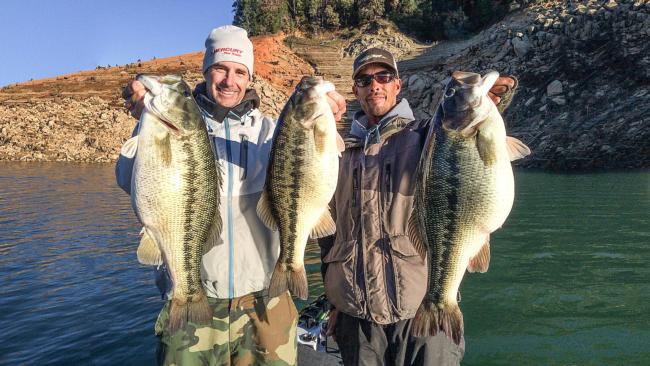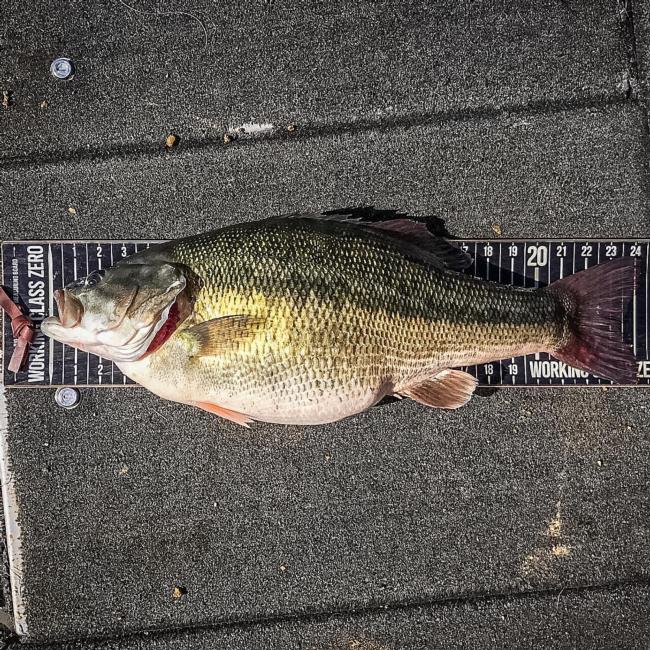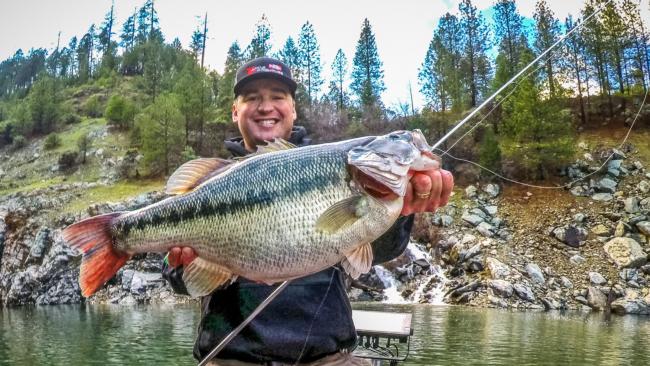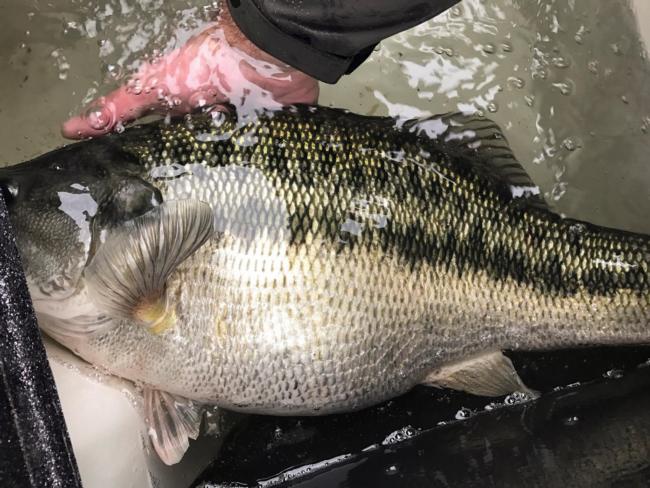Mistaken Identity?
IGFA world record spotted bass under the genetic microscope
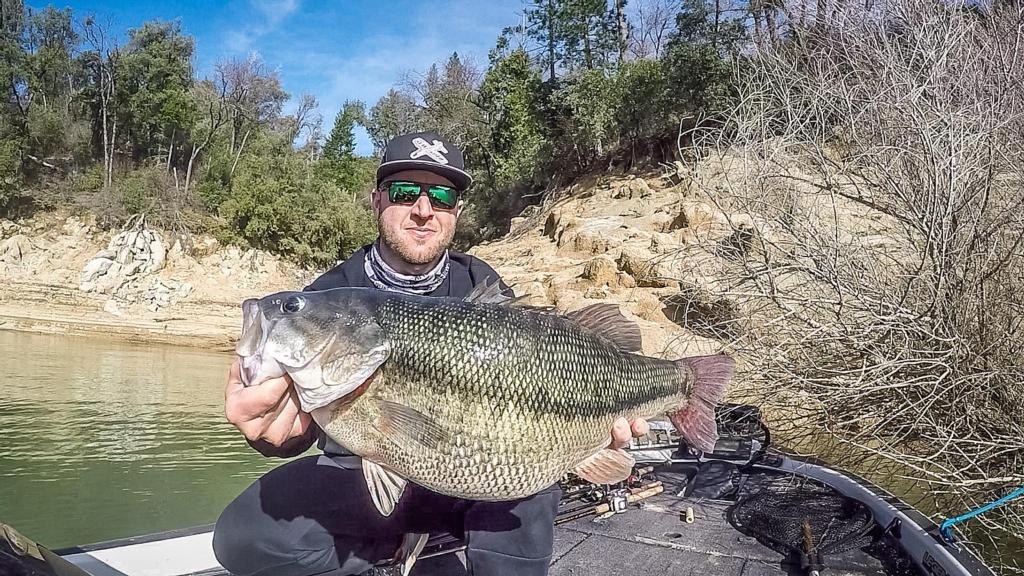
(Editor’s note: Matt Williams is an FLW Bass Fishing magazine field editor and freelance writer based in Nacogdoches, Texas. A version of this article recently ran in several newspapers in east Texas as part of his syndicated outdoor column. He can be reached by e-mail at [email protected].)
If you run in bass fishing circles or keep check on developments within the sport as closely as I do, then you have probably heard about all those huge “spotted” bass that have been caught out West over the last few years. The drums have been beating particularly loud in California, where reports and photos of anglers holding fistfuls of enormous bass with short bodies, fat bellies and gorgeous color have been showing up on social media and on a number of popular websites for quite some time.
In May, the International Game Fish Association (IFGA) officially declared one of the fish a new world record in its spotted bass category. The 11-pound, 4-ounce beauty was caught by Nick Dulleck of San Jose, Calif., on Feb. 12, 2017 from New Bullards Bar Reservoir near Yuba City, Calif. It’s the same lake that produced Timothy Little’s former world record spot of 10 pounds, 2 ounces in 2015 and a host of challengers since, including a 10.80-pounder caught in December 2016 by FLW Tour pro Cody Meyer.
In a surprising turn of events, an official at the IGFA has said that the organization might have to reconsider whether or not Dulleck’s fish is the spotted bass world record and possibly award him an Alabama bass all-tackle world record instead.
It’s not that there was something shady about the catch or anything of the sort. Dulleck caught the fish legally and followed all the IGFA world record application requirements to a T.
The hitch falls under the subject of science and a potential case of mistaken identity, according to Jason Schratweiser, IGFA conservation director, and whether or not this fish is a true spotted bass or an Alabama bass, a similar-looking yet different species altogether.
Alabama bass: a fish of a different kind
According to some fisheries experts, the big bass that took Dulleck’s bait last spring might not have been a spotted bass (Micropterus punctulatus; other common names: Kentucky spotted bass, northern spotted bass) as everyone has been claiming for months. In fact, some scientists believe Dulleck’s fish – and several other big bass hauled in prior to it at New Bullards Bar – was an entirely different breed, likely pure Alabama bass (Micropterus henshalli) or an Alabama bass hybrid of some sort. The Alabama bass, formerly thought to be a subspecies of spotted bass, is now considered to be its own distinct species by the American Fisheries Society.
Dr. Steven M. Sammons with the School of Fisheries, Aquaculture and Aquatic Sciences at Auburn University has seen pictures of Dulleck’s fish and says its sheer size indicates it is most likely not a spotted bass. Sammons has performed extensive research on nine different species of black bass, including Alabama bass, over the last 23 years.
“All those big ‘spotted bass’ in California are Alabama bass,” Sammons says. “Actual spotted bass rarely get over 3 pounds and virtually never over 5 pounds. I worked in Tennessee on reservoirs for five years [with all native spotted bass, no Alabama bass] and never saw one over 2 1/2 pounds.”
Getting a name change
Alabama bass are native to the Mobile River basin of Alabama, Georgia and Mississippi. Spotted bass naturally inhabited a range extending from east Texas to eastern Kansas, across the middle and southern parts of Illinois, Indiana and Ohio to the Appalachians, and down to the Gulf of Mexico. For years scientists recognized Alabama bass as one of three subspecies of spotted bass, hence the former name “Alabama spotted bass” that existed until scientists determined through DNA analysis and other research that Alabama bass and spotted bass are entirely different animals, particularly when it comes to growth potential.
As a result, the American Fisheries Society (AFS) in 2013 designated the Alabama bass as a species unto its own. Established in 1870, the AFS is a non-profit organization comprised of fisheries professionals nationwide whose goals are to advance fisheries and aquatic science and to promote the development of fisheries professionals.
Schratwieser, of the IGFA, says he wasn’t made aware of the AFS’s stance on Alabama bass until recently, and he pointed out that the designation has created a somewhat sticky situation that the IGFA is attempting to sort out, as genetics testing was not done on Dulleck’s record fish to verify species. The IGFA is recognized and highly respected as the keeper of world record fish catches in a variety of categories.
“We have to get this right,” Schratwieser says. “I’m going to have to rely on biologists to help us sort this out. It’s a mess.”
Dulleck speaks
And caught in the middle of the mess is Dulleck, a 33-year-old angler who lives and breathes bass fishing and claims he went above and beyond to document his catch in order to leave absolutely no question as to its authenticity.
Dulleck, who says he received an e-mail from IGFA notifying him that his all-tackle spotted bass world record might be exchanged for an Alabama bass record, says he is somewhat confused by the recent turn of events.
“I’m aware of the different species, but I think there are a lot of unanswered questions around the process of what they [the IGFA] are trying to do,” he says. “There needs to be some questions answered as far as how they are going to handle it. There are a lot of different aspects to look at – a lot of unknowns. There are several IGFA spotted bass line-class records to be looked at and other fish in the 8- to 9-pound class that have been caught in California and recognized in the past. Do we say all big spots in California are Alabama bass? There are a lot of lines to be drawn, so I don’t think it’s going to be an easy process for IGFA.
“But, at the end of the day it is what it is,” he adds. “If I wind up with the world record for Alabama bass, that’s cool, too. It seems to me that is more than likely what is going to happen, and I’m fine with that. My main concern is that this deal gets handled in a way that is fair for everyone going forward.”
Spreading the genes
Alabama bass have found their way into new water bodies over the years, in some cases through illegal releases and others via state agency stockings. The California Department of Fish and Wildlife stocked Alabama bass into New Bullards Bar in 1983 and 1984, according to CDFW environmental scientist Max Fish.
As earlier mentioned, the Alabama transplants have apparently done pretty well in the fertile Yuba County reservoir, where fat, healthy fish weighing upward of 6 pounds don’t even raise eyebrows anymore.
Dr. Michael Maceina, also a fisheries scientist at Auburn University, says the heaviest angler-caught Alabama bass he is aware of in its native range weighed 8 pounds, 15 ounces. He believes the magnum size of the fish coming out of New Bullards Bar and other California reservoirs could be attributed to a combination of diet, habitat conditions and possibly even low-density populations.
“Finally, invader or exotic species sometimes do really well when first introduced,” Maceina says. “It’s amazing to see how much larger Alabama bass get in California compared to the size in their native range.”
That’s a good foundation for the next question: Would it be possible for a native spotted bass to reach double digits on a protein-rich diet of kokanee salmon like Dulleck says New Bullards Bar fish are privy to?
Sammons doesn’t think so.
“Fish have what ecologists call a ‘scope of growth,’ which means that they have biological and genetic limits on how big they can grow,” he says. “Largemouth bass do not grow to 40 pounds, but striped bass do regularly. It is no different with spotted bass and Alabama bass. The scope of growth is just completely different. Diet plays a small effect, but it will not just double the size that a fish can reach.”
What about state record spotted bass in places such as Arkansas (7 pounds, 15 ounces) and Missouri (7 pounds 8 ounces), where the recognized fish surpassed 7 pounds? Though he didn’t handle the fish directly, Sammons suggested several explanations.
“My guess is hybrids or possibly Alabama bass,” said Sammons via email. “When it comes to state records, you can never pass on the notion that it was just a genetic freak. The difference between a state record and the situation in California is the number of big fish. No one [as far as I know] is catching loads of 5-pound ‘spots’ from either Arkansas or Missouri. Those records were odd fish, whether hybrids or the real deal. But when you see a steady stream of ever-bigger fish coming from a lake or a state, it seems pretty obvious what is happening. I knew there were some pretty large state records in places where the fish ‘should’ be the real deal [i.e., no introductions that we know of]. But the drop-off between that fish and what takes ‘big fish’ in tourneys is pretty dramatic. In Arkansas, I have reviewed several recent studies on the Arkansas River chain of lakes, and there, spots rarely exceed 16 inches … just like spotted bass everywhere else.
“State records CAN be a lot bigger than average, because genetics is a weird thing, and every once in awhile you get some freak that grows twice as fast as everyone around him/her. I think most state records are like that.”
Texas establishes genetic testing protocol
Alabama bass also have taken root in Texas, but only in one lake. Lake Alan Henry, a 2,900-acre reservoir near Lubbock, was stocked with 150 adult Alabama bass in 1996 as part of an experiment. Like many other lakes across the state, Alan Henry does not have a spotted bass population.
In January 2016, a 5.98-pound state record caught there underwent genetics testing to determine its origin. The test showed the fish to have pure Alabama bass DNA, linking it to the stocking that was performed 20 years earlier.
In light of the AFS ruling designating Alabama bass as a distinct species, the Texas Parks and Wildlife Department (TPWD) elected to establish separate records and regulations categories for Alabama bass that become effective Sept. 1, 2017.
Craig Bonds, TPWD inland fisheries director, says the decision to create a separate category for Alabama bass was the only logical thing to do.
“Our policy is to follow fish species designations based on the names of fishes prescribed by the AFS,” Bonds says. “Following a state record submission for the catch of a supposed spotted bass from Lake Alan Henry in 2016, where Alabama bass were stocked in 1996, we felt it appropriate to add Alabama bass as a species in our black bass regulations, as well as make the change to our Angler Recognition Program [which recognizes fish records and other notable catches throughout Texas].”
For years, TPWD fisheries scientists have relied on genetics testing to sort out pure Florida bass from intergrades turned into the agency’s high-profile Toyota ShareLunker program. Officials there maintain the belief that such testing using a fin clip or scale is the only definitive way to tell the difference between spotted bass, Alabama bass and their hybrids.
“It’s a misnomer among some of the angling public that you can positively identify species by looking at shape, coloration and things like that,” Bonds says. “The only definitive way to differentiate species for black bass that readily hybridize with each other is through genetics testing.”
The Tennessee Wildlife Resources Agency (TWRA), one of the only state agencies to currently recognize spotted bass and Alabama bass separately in its record books, went a similar route as Texas officials when this issue arose. The agency lists a 6-pound, 1-ounce fish caught from Lake Chickamauga in 2011 as the state record for spotted bass. A 7-pounder caught from Parksville Reservoir in 2014 holds the Tennessee state record for Alabama bass. According to Frank Fiss, inland fisheries chief with the TWRA, both fish were verified for species through genetics testing. In Parksville, which is upstream of Chickamauga, Alabama bass were illegally introduced, and Fiss verified that some Alabama bass DNA has been found in Chickamauga. The tests were necessary to verify species.
The CDFW has chosen to take a different route. According to Fish, that agency now places spotted bass and Alabama bass under the same records heading in California rather than opting for genetics testing to verify the origin of record-class fish.
“Genetic work is near a necessity for absolute confirmation of species,” Fish said via e-mail. “CDFW does not have the resources to do genetic work on state record applications at this time. For this reason both species are combined in one record category to preserve accuracy.”
At this point, there’s no evidence that there’s any genetic material available from Dulleck’s trophy fish for positive species identification.
“I found no records of authorized stocking of any spotted bass into New Bullards Bar other than [the then recognized] Alabama spotted bass I referenced in an earlier email,” Fish added in a later email message. “I believe the kokanee are probably a superior forage for large bass, and many of the lakes that support trophy spot/Alabama fisheries also support kokanee fisheries. I believe it is likely that the big spots we’ve seen recently are Alabama bass or Alabama hybrids, but I have not done the thorough record search on the other lakes as I have done on Bullards.”
The fate of IGFA’s newest world record appears to be up in the air. Is the fish a spot, Alabama bass or some sort of hybrid? In any case, it’s one whale of a fish well deserving of a mountain of recognition.
Only time will tell how this one shakes out.
